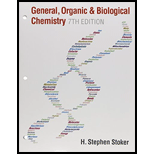
Concept explainers
Interpretation: To identify the correct pairs of processes that are the reverse of each other in terms of initial reactant and final product.
Concept introduction: Monosaccharides are the simplest carbohydrate units which cannot be hydrolyzed further to give the smallest units. Glucose is a monosaccharide with the molecular formula
Polysaccharides contain many carbohydrate units that vary from 100 to 50,000 monosaccharide units. Glycogen is a polysaccharide of glucose. It serves as a form of carbohydrate storage in humans and animals. Glycogen is a source of glucose in humans and animals.
A reactant is defined as the substance that is initially present in the
Trending nowThis is a popular solution!

Chapter 24 Solutions
Bundle: General, Organic, and Biological Chemistry, 7th + OWLv2 Quick Prep for General Chemistry, 4 terms (24 months) Printed Access Card
- In which of the following listings of citric acid cycle intermediates are the compounds listed in the order in which they arc encountered in a turn of the cycle? a. isocitrate, oxaloacetate, succinate b. succinate, malate, oxaloacetate c. citrate, oxaloacetate, fumarate d. no correct responsearrow_forwardWhat are the typical fates for fatty acids in the liver (select all that apply)? O They are oxidized and converted into ketone bodies. O They are oxidized to yield acetyl-CoA and NADPH. O They are used to synthesize triacylglycerol. O They are oxidized and converted into glucose. O They are oxidized and used in the synthesis of cholesterol.arrow_forwardWhich of the following hormones increases blood glucose levels? a. glucagon and epinephrine b. insulin and epinephrine c. insulin and glucagon d. more than one correct response e. no correct responsearrow_forward
- 15.7) Determine whether each of the following changes is an oxidation or reduction. a) gain of electrons reduction b) loss of electrons oxidation c) Fe²+ to Fe³+ oxidation d) NADH to NAD+ oxidation lost bond to hydrogen atom e) FAD to FADH₂ reduction gained bond to hydrogen atom f) CH4 to CO₂ oxidation gained bonds to oxygen atoms and lost bonds to hydrogen atoms g) NAD+ to NADH reduction gained bond to hydrogen atom EXPLANATION: A useful mnemonic to differentiate oxidation and reduction is the term "OILRIG" (Oxidation is the Loss of electrons; Reduction is the Gain of electrons). It is possible to identify redox reactions for inorganic compounds by inspecting the chemical equation and determining if electrons are transferred from one species to another. If the charge of an atom or ion in a reactant was increased (toward positive) in the conversion of reactants to products, an oxidation occurred. If the charge of an atom or ion in a reactant was decreased (toward negative) in the…arrow_forwardQUESTION 6 What Citric Acid Cycle intermediate is derived from the following amino acid? HO Citrate Aconitate Isocitrate NH₂ H₂ H₂ -C -C -CH Alpha-Ketoglutarate OH |arrow_forwardQuestion. What is the process of glucose creation from lactate, pyruvate, and amino acids? saccharification glycogenolysis gluconeogenesis glycolysis hydrolysis Question 6 What conformation of B subunits contributes to form ATP? F1 conformation open conformation loose conformation tight conformation O conformationarrow_forward
- Question 28 CHOH CHOH A CHOH CHOH 1 CH2 CHOH OH OH OH CH 3 CHOH OH OH он CH он он B 2 OH CH Which lettered subunit is the reducing end? O A В There is more than one reducing end on this sugar structurearrow_forwardWhich of the following statements concerning the degradation of standard amino acid carbon skeletons is correct? a. Each type of carbon skeleton is degraded to a different product. b. All carbon skeletons are degraded to the same product. c. Each type of carbon skeleton is degraded by a different metabolic pathway. d. no correct responsearrow_forward
 General, Organic, and Biological ChemistryChemistryISBN:9781285853918Author:H. Stephen StokerPublisher:Cengage Learning
General, Organic, and Biological ChemistryChemistryISBN:9781285853918Author:H. Stephen StokerPublisher:Cengage Learning Organic And Biological ChemistryChemistryISBN:9781305081079Author:STOKER, H. Stephen (howard Stephen)Publisher:Cengage Learning,
Organic And Biological ChemistryChemistryISBN:9781305081079Author:STOKER, H. Stephen (howard Stephen)Publisher:Cengage Learning,
 Introduction to General, Organic and BiochemistryChemistryISBN:9781285869759Author:Frederick A. Bettelheim, William H. Brown, Mary K. Campbell, Shawn O. Farrell, Omar TorresPublisher:Cengage Learning
Introduction to General, Organic and BiochemistryChemistryISBN:9781285869759Author:Frederick A. Bettelheim, William H. Brown, Mary K. Campbell, Shawn O. Farrell, Omar TorresPublisher:Cengage Learning



